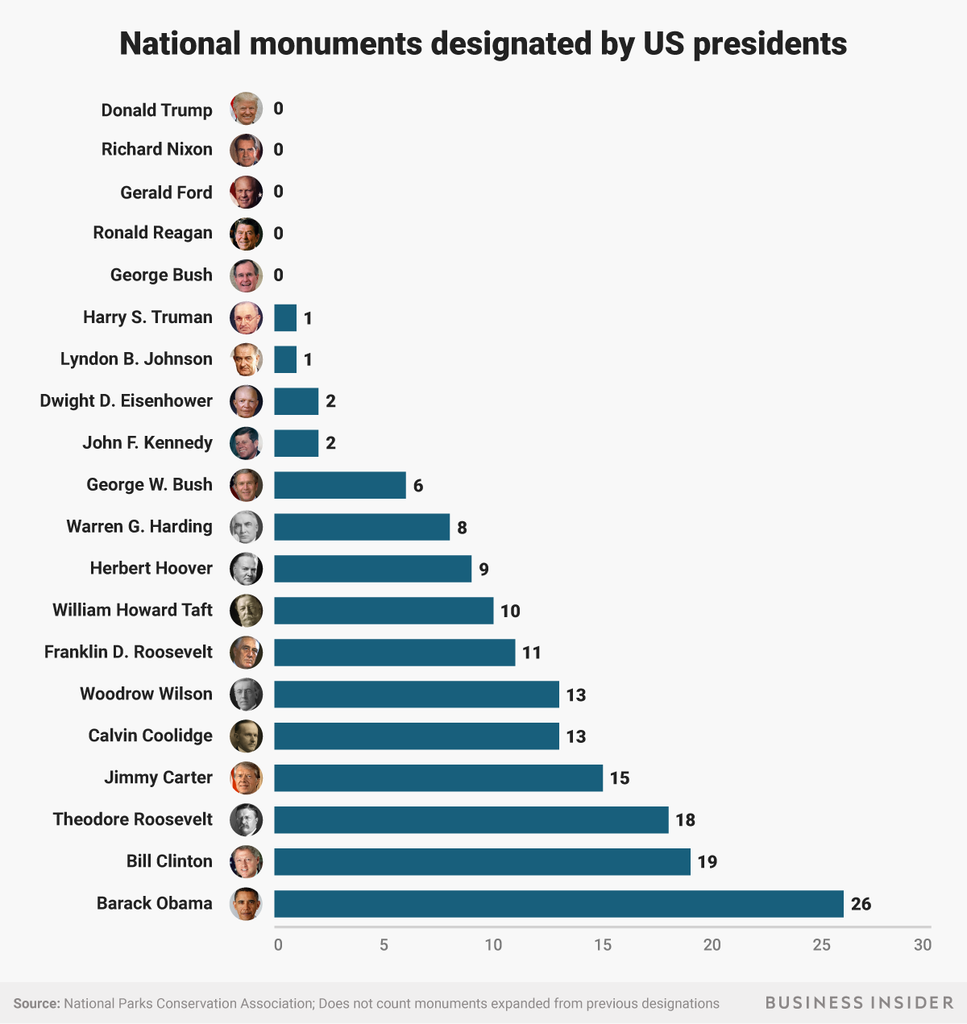- President Donald Trump’s administration has dramatically reduced the size of Bears Ears National Monument and Grand Staircase-Escalante National Monument – the largest reduction of protected land to date.
- Some presidents have made conserving land a priority, while others have opted not to use their power to do so.
- Here are the presidents who have protected the most land – and the ones who haven’t.
President Donald Trump’s administration has shrunk two protected areas in Utah: Bears Ears and Grand Staircase-Escalante National Monuments.
The size of Bears Ears was reduced by 85% – a loss of 1.1 million acres – and Grand Staircase-Escalante was cut by half.
The reductions were based on recommendations from Secretary of the Interior Ryan Zinke, who suggested changes to 10 monuments in September 2017. Various environmental and indigenous groups are now fighting the decision in court.
Bears Ears was declared a national monument by former President Barack Obama in 2016. The area is sacred to local Navajo tribes. But Utah Senator Orrin Hatch criticized Obama’s decision to protect the area as a “federal land grab.”
Unlike national parks, which are created through Congress, national monuments are designated by US presidents under the Antiquities Act, which gives them the power to set aside public land for conservation. Former President Theodore Roosevelt signed the act into law in 1906 and used it to protect Muir Woods and the Grand Canyon (which has since become a national park), along with 16 other areas.
While each monument is subject to its own rules, most don't allow any motorized vehicles and forbid using the land for mining or drilling operations.
Trump isn't the first president to shrink a national monument - Eisenhower, Truman, Taft, Wilson, and Coolidge all did so, but their reductions accounted for much less land area than Trump's.
US courts haven't ruled on whether presidents actually have the power to shrink monuments, so a future legal decision could impact protected lands across the country.
Trump has yet to establish any new national monuments, though Zinke has proposed three options: the Civil War-era Camp Nelson in Kentucky, Medgar Evers' home in Mississippi, and a swath of the Lewis and Clark National Forest in Montana.
Obama, on the other hand, used the Antiquities Act to protect more than 550 million acres throughout his time in office, significantly more than any of his predecessors. His first monument designation came two years into his presidency, on November 1, 2011, when he established a 325-acre park around Fort Monroe in Hampden, Virginia.
Here's a ranking of the presidents who protected the most land since the inception of the Antiquities Act:
Donald Trump: 0 national monuments

National monument acreage designated by Trump: 0 acres
Richard Nixon: 0 national monuments

National monument acreage designated by Nixon: 0 acres
Gerald Ford: 0 national monuments

National monument acreage designated by Ford: 0 acres
Ronald Reagan: 0 national monuments

National monument acreage designated by Reagan: 0 acres
George Bush: 0 national monuments

National monument acreage designated by Bush: 0 acres
Harry Truman: 1 national monument

National monument acreage designated by Truman: 2,526 acres
Lyndon B. Johnson: 1 national monument

National monument acreage designated by Johnson: 26,080 acres
Dwight Eisenhower: 2 national monuments

National monument acreage designated by Eisenhower: 4,821.25 acres
John F. Kennedy: 2 national monuments

National monument acreage designated by Kennedy: 1,160 acres
George W. Bush: 6 national monuments

National monument acreage designated by Bush: 218.8 million acres
Warren G. Harding: 8 national monuments

National monument acreage designated by Harding: 8,078.1 acres
Herbert Hoover: 9 national monuments

National monument acreage designated by Hoover: 1.4 million acres
William Howard Taft: 10 national monuments

National monument acreage designated by Taft: 38,715 acres
Franklin Roosevelt: 11 national monuments

National monument acreage designated by Roosevelt: 3 million acres
Like his distant cousin Theodore Roosevelt before him, FDR was instrumental in protecting the US wilderness. Joshua Tree in California, and Jackson Hole in Wyoming, are some of his most famous designations.
Woodrow Wilson: 13 national monuments

National monument acreage designated by Wilson: 1.2 million acres
Calvin Coolidge: 13 national monuments

National monument acreage designated by Coolidge: 1.5 million acres
Jimmy Carter: 15 national monuments

National monument acreage designated by Carter: 56 million acres
Carter focused on protecting lands in Alaska - he protected a total 56 million acres in the state in 1978 through the Antiquities Act. But that move was controversial among Alaskans at the time.
Theodore Roosevelt: 18 national monuments

National monument acreage designated by Roosevelt: 1.5 million acres
Roosevelt can be seen as instrumental in the creation of all national monuments in the US, since he signed the Antiquities Act into law in 1906.
Of the 18 National Monuments he designated, Muir Woods, which is near San Francisco, is perhaps the most famous.
Bill Clinton: 19 national monuments

National monument acreage designated by Clinton: 5.7 million acres
Barack Obama: 26 national monuments

National monument acreage designated by Obama: 553.5 million acres
Obama protected more land than any other president during his term, though Trump has rolled some of that back by shrinking Bears Ears National Monument, by 85%.
The majority of Obama's addition to the nation's protected acreage was sea ecosystems, since he created and expanded several large marine national monuments in the Atlantic and Pacific oceans.
Here are the nine presidents who've protected the most acreage.

As is clear from the data above, the number of national monuments that a president established doesn't tell the whole story, since monuments vary greatly in size.
Obama, however, created the most monuments and preserved the biggest land area of all US presidents.
